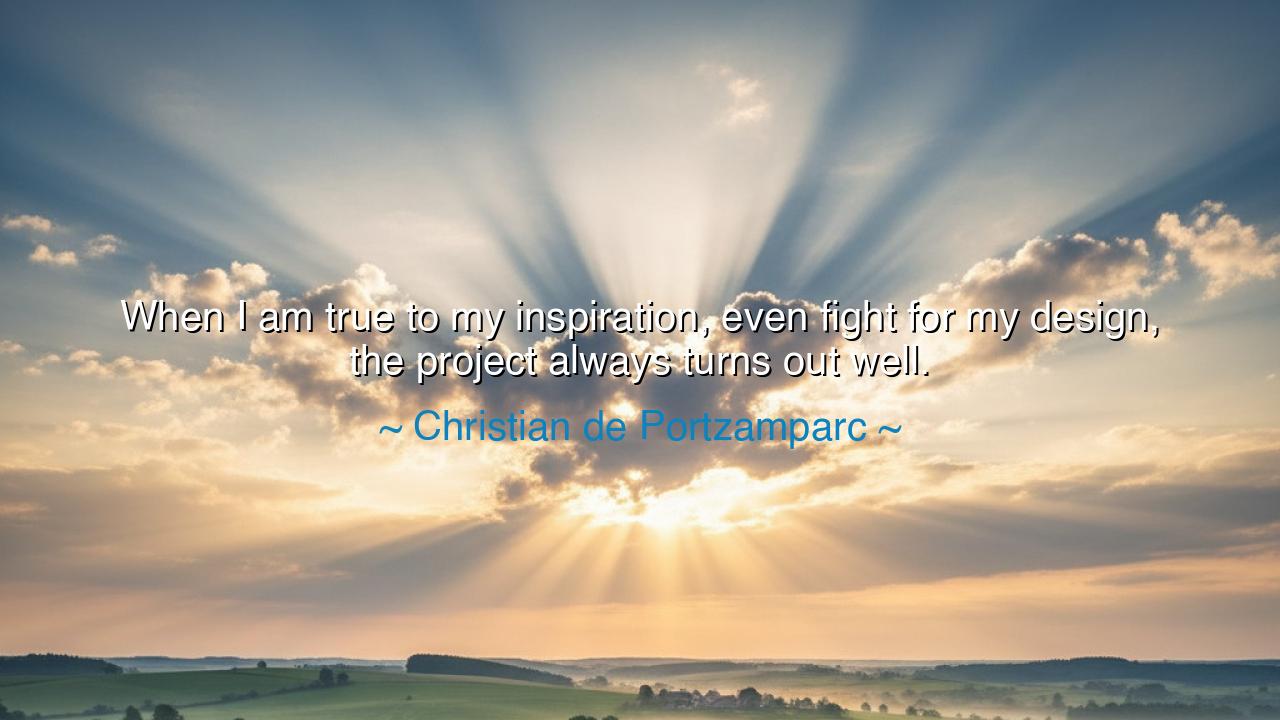
When I am true to my inspiration, even fight for my design, the
When I am true to my inspiration, even fight for my design, the project always turns out well.






When Christian de Portzamparc, the French architect and visionary of form and light, proclaimed, “When I am true to my inspiration, even fight for my design, the project always turns out well,” he spoke not only of architecture, but of the eternal struggle between conviction and compromise. His words carry the quiet thunder of all creators who have ever wrestled with doubt and opposition, yet remained faithful to their inner vision. In this single line lies a truth as old as human creation itself — that greatness is born when the soul refuses to yield, when one remains loyal to the voice within, even as the world demands surrender.
Portzamparc’s life has been one of boldness shaped by integrity. As an architect, he was not content to merely construct buildings; he sought to sculpt space into poetry, to make the invisible visible. His designs — fluid, daring, luminous — often challenged convention. There were times when others could not see what he saw, when committees doubted, when practicality tried to cage imagination. Yet, as he himself confessed, it was only when he stood firm — when he fought for his design, protecting the purity of his inspiration — that the final creation truly sang. His success was not luck; it was the reward of courage. For in the realm of art, and indeed in all creation, faithfulness to one’s inspiration is the first law of greatness.
In this, Portzamparc stands in the long lineage of those who dared to defy conformity in service of truth. Consider Michelangelo, who, when asked to paint the Sistine Chapel ceiling, was commanded to follow the pope’s vision. Yet he refused to be guided by another’s hand. Against power, against exhaustion, against fear, he remained true to his inspiration — and in doing so, he painted eternity. So it is with all masters: Leonardo, who saw flight where others saw folly; Gaudí, who sculpted faith into stone at Sagrada Família despite ridicule and poverty; Beethoven, who wrote symphonies though deafness silenced the world around him. Each fought for their design — and by doing so, transcended mere craft to touch the divine.
The fight for one’s vision is not an act of arrogance, but of obedience — obedience to the higher calling that speaks through the heart. Inspiration is a sacred fire, delicate yet powerful, that demands both protection and courage. Many lose it by listening to the noise of others — the critics, the financiers, the cautious voices that say, “It cannot be done.” But those who preserve it, who guard that spark through the storm, become vessels of creation itself. Portzamparc’s quote, therefore, is not a boast, but a commandment: Remain true, even when the path is lonely. For what is creation if not the triumph of spirit over fear?
And yet, to be true to one’s inspiration is not the same as stubborn pride. The ancients taught that the greatest wisdom lies in listening deeply — to the muse, to the materials, to the purpose that flows through the work. What Portzamparc reveals is that the artist’s fight is not against the world, but against the temptation to betray oneself. The battle is inward. Once the creator yields to convenience or fear, the work loses its soul. But when the creator stands steadfast — humble before the muse, but unyielding before compromise — then the work becomes alive, radiant, inevitable. It “turns out well,” not by chance, but by the harmony of truth made manifest.
This lesson extends beyond the walls of art. It is the same for all who build — whether one shapes stone, leads a people, writes a book, or lives a life. To betray one’s inspiration is to build upon sand; to honor it is to lay a foundation of rock. When a person lives by truth rather than approval, when they dare to stand by the design of their own soul, every project of their life — work, love, legacy — begins to align with purpose. The world may resist at first, but time always bows before authenticity.
So hear this, O seeker of meaning: the fight for your design is sacred. Let others mock your vision — you must still guard it. Let obstacles rise — you must still persist. For inspiration is not a gift to be wasted, but a responsibility to be honored. Portzamparc’s words remind us that beauty and greatness are never born from ease; they are carved by struggle, defended by will, and crowned by faith.
And in the end, when you have fought for your design — your truth, your dream, your life’s purpose — and remained true to it, you shall look upon your creation, whether a building, a song, or a life well-lived, and say with quiet pride: It has turned out well. Not because it is perfect, but because it is true.






AAdministratorAdministrator
Welcome, honored guests. Please leave a comment, we will respond soon